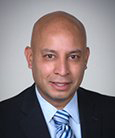Luis G. Villa-Diaz

Luis G. Villa-Diaz
Assistant Professor, D.V.M., Ph.D.
305 MSC
(248) 370-2576
Lab location: 304 MSC
Lab phone: (248) 370-4903
[email protected]
Villa-Diaz lab website
Courses:
BE 4400 Tissue Engineering
BIO 2640 Comparative Physiology
Research:
Interconnection between human pluripotent stem cells and the extracellular matrix
Human pluripotent stem cells (hPSCs), which include embryonic stem cells (ESC) and induced pluripotent stem cells, have a great potential for use in regenerative medicine, drug development, disease modeling and developmental biology. These cells have the capacity of in-vitro unlimited self-renewal and a differentiation potential to all cell types in the body.
Dr. Villa-Diaz’s research focuses on understanding and elucidating the self-renewal properties of hPSCs, which are influenced by the microenvironment in which they are cultured, in particular the extracellular matrix (ECM). The ECM is a multifunctional regulator of cellular behavior serving functions beyond those as a scaffold for the organization of cells into tissues. ECM proteins modulate the activity and bioavailability of growth factors, cytokines, and chemokines via direct binding and signaling via cell-surface receptors including integrins and matricellular proteins, to regulate cellular functions.
His research has shown that the self-renewal of human pluripotent stem cells (hPSC) is influenced by ECM deposition of feeder-cells, nanotopography cues, material mechanics, chemical composition and the structural arrangements of substrates. Therefore, the central hypothesis and main focus of his research is the fate of hPSCs and how they can be directed towards self-renewal and cell-lineage differentiation by molecular mechanisms initiated by ECM components and the microenvironment for the creation of an in vitro model for early events in development.
Selected Publications:
Luis G. Villa-Diaz NCBI publication list
Qiryaqoz, Z., S. Timilsina, D. Czarnowski*, P.H. Krebsbach and L.G. Villa-Diaz. (2019) Identification of biomarkers indicative of functional skeletal stem cells. Orthodontics & Craniofacial Research. 22 (Suppl.1): 192-198. DOI: 10.1111/ocr.12260.
Bigoni-Ordóñez, G.D., D. Czarnowski*, T. Parsons*, G.J. Madlambayan and L.G. Villa-Diaz. (2019). Integrin α6 (CD49f), the microenvironment and cancer stem cells. Current Stem Cell Research & Therapy 14(5): 428-436. DOI: 10.2174/1574888X13666181002151330.
Ramotowski, C., X. Qu and L.G. Villa-Diaz. (2019). Progress in the use of induced pluripotent stem cell-derived neural cells for traumatic spinal cord injuries in animal populations: Meta-analysis and review. Stem Cell Translational Medicine: Epub ahead of print. DOI: 10.1002/sctm.18-0225.
Tugba T., B.C. Kim, L.G. Villa-Diaz, C. Deng, S. Takayama and P.H. Krebsbach. (2019). Rapid translocation of pluripotency-related transcription factors by external uniaxial forces. Integrative Biology: Epub ahead of print DOI: 10.1093/intbio/zyz003.
Chen, W., S. Han, W. Qian, S. Weng, H.Yang, Y.Sun, L.G. Villa-Diaz, P.H. Krebsbach and J. Fu. (2018) Nanotopography regulates motor neuron differentiation of human pluripotent stem cells. Nanoscale 10: 3556-3565. DOI: 10.1039/c7nr05430k.
Krebsbach, P.H. and L. G. Villa-Diaz. (2017). The Role of Integrin α6 (CD49f) in Stem Cells: More than a Conserved Biomarker. Stem Cells and Development 26(15): 1090-1099. DOI: 10.1089/scd.2016.0319.
*OU student
Department of Biological Sciences
118 Library Dr
Rochester, MI 48309-4479
(location map)
(248) 370-3550
fax: (248) 370-4225
[email protected]

